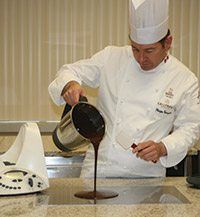Mixers and blenders are staples in fine dining and QSR operations alike, but while the machines’ basic mechanics haven’t changed much, their functionality is taking on a new spin for chefs who like to make the most of a good thing.
John Placko, chef and culinary director at the Modern Culinary Academy in Mississauga, Ont., classifies blenders and mixers into three key categories: portable/ immersion blenders; countertop blenders for drink preparations; as well as multifunction units that can weigh, chop, blend, steam and/or cook.
Immersion and hand blenders, along with their various attachments — from blades to whisks — have been a staple in kitchens since the 1950s. They’re the go-to appliances for on-the-spot puréeing, whipping and basic chopping needs. Placko notes the BamixSliceSy from ESGE Ltd. in Switzerland is one of the ultimate brands in terms of functionality and versatility. But, once you move up the appliance food chain, it gets more interesting.
Counter intelligence
Vitamix has become a fairly ubiquitous name in foodservice operations that use countertop food-prep units. “They’re expensive but powerful, and they don’t burn out,” Placko says, of the machines that cost $800 or more, depending on size and functionality.
Nigel Babb, senior operations manager for Booster Juice in Toronto, agrees, noting that Vitamix blenders are standard at the 300-store chain, due to their durability, ease of use and power. “Most of our stores have three to five Advance or Quiet One models,” Babb explains. “The mechanisms and pricing are the same for both. The Quiet One is just a bit more compact and quieter, of course.” Having relied on top-of-the-line blenders since the company was founded 13 years ago, Babb prefers to invest in a high-end unit. “Some of our locations could be mixing 200 drinks per blender per day,” he says. “With a quality blender, we can easily go five years without any problems.”
And, while the overall design and blade configurations haven’t changed much during the past years, pre-programming features have been added to the mix. For Booster Juice, these configurations are input at the factory based on brand specifications. The new feature allows users to execute different combinations of speed cycles with the push of a single button. For example, one setting could run at high speed for a few seconds and then automatically adjust to a lower speed to allow fruit to drop to the blades for better blending. Newer Vitamix models feature the motor higher in the housing, so they can sit above the countertop deck, which increases air circulation and reduces the chance of overheating, Babb explains.
It’s complicated
When it comes to more complex food-preparation needs, multifunction units are becoming popular in restaurant kitchens. And, although some cost up to $5,000, they can be invaluable, Placko notes. “These multifunction tools provide people with more simplicity, labour savings and consistent results when it comes to food preparation. That’s why we’re seeing a lot more of them in kitchens today.”
Meanwhile, Patrick Watt, founder and principal of A Day in Life Foodservice Development, a Saint John, N.B.-based consultancy, notes that the Robot Coupe Blixers are becoming an increasingly popular investment, because they combine mixing and blending into one. “A lot of institutional kitchens use them just for puréeing, but they can also be used for pastries. It’s a product that’s underutilized but has a lot of potential.”
Priced at $1,800, the Thermomix is also gaining traction in the foodservice market, Placko says. “[It] will weigh the ingredients, blend and cook as well as allow you to pre-set times and speed. You’ll see at least one or two in any good restaurant; some have as many as six, because they allow for such precise cooking.”
Chocolatiers are fans of Thermomix, too. Philippe Vancayseele, director of Callebaut’s Chocolate Academy in St-Hyacinthe, Que., has been using the technology for a long time. “It’s used by more professionals in Europe, many of whom are using it more for chocolate or ganache making,” says the Belgian Callebaut director.
It’s become so useful that the chocolatier never travels without it. “It’s the first thing I [take] out when doing demonstrations,” he says. So, what’s the big draw? This blender system features four knives instead of the traditional two; it allows for high-speed grinding of food items such as hazelnuts, without creating dust or generating too much heat. “More knives mean you can cut faster,” adds Vancayseele, who mainly uses his Thermomix for ganache preparation, although it’s also ideal for mixing dough and creams.
Albert Ponzo, chef at Le Sélect Bistro in Toronto, has two Thermomix units in his kitchen, which he uses for making hollandaise and butter sauces. “They emulsify nicely and hold the temperature, so you end up with a superior product. It’s also really nice for spice rubs, because the revolutions are so fast you can pulverize them into powders. You just throw in your cloves and black pepper and let it rip.” He admits the machines may be pricey but confirms they’re worth the cost.
Ponzo also inherited a Pacojet, which he uses to make ice cream, sorbet and purée. “You can take a base, freeze it in canisters, ‘pacotize’ it and end up with an incredibly velvety smooth textured produce. The yield is even higher than the Thermomix, because you don’t lose anything in the process.”
The beauty of top-rate mixing and blending equipment is that a wise investment will stand the test of time. Ponzo’s floor model Globe mixer that he uses for baking and bread making is six years old and still runs smoothly; his Pacojet is seven years old and continues to do a bang-up job. “[The] old food processor I use to grate cheese is probably as old as I am,” he jokes.





















